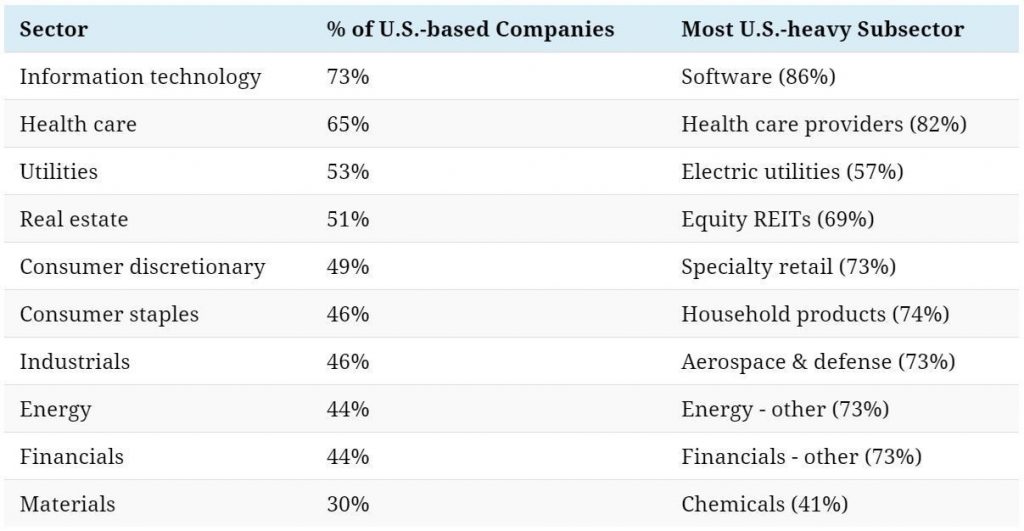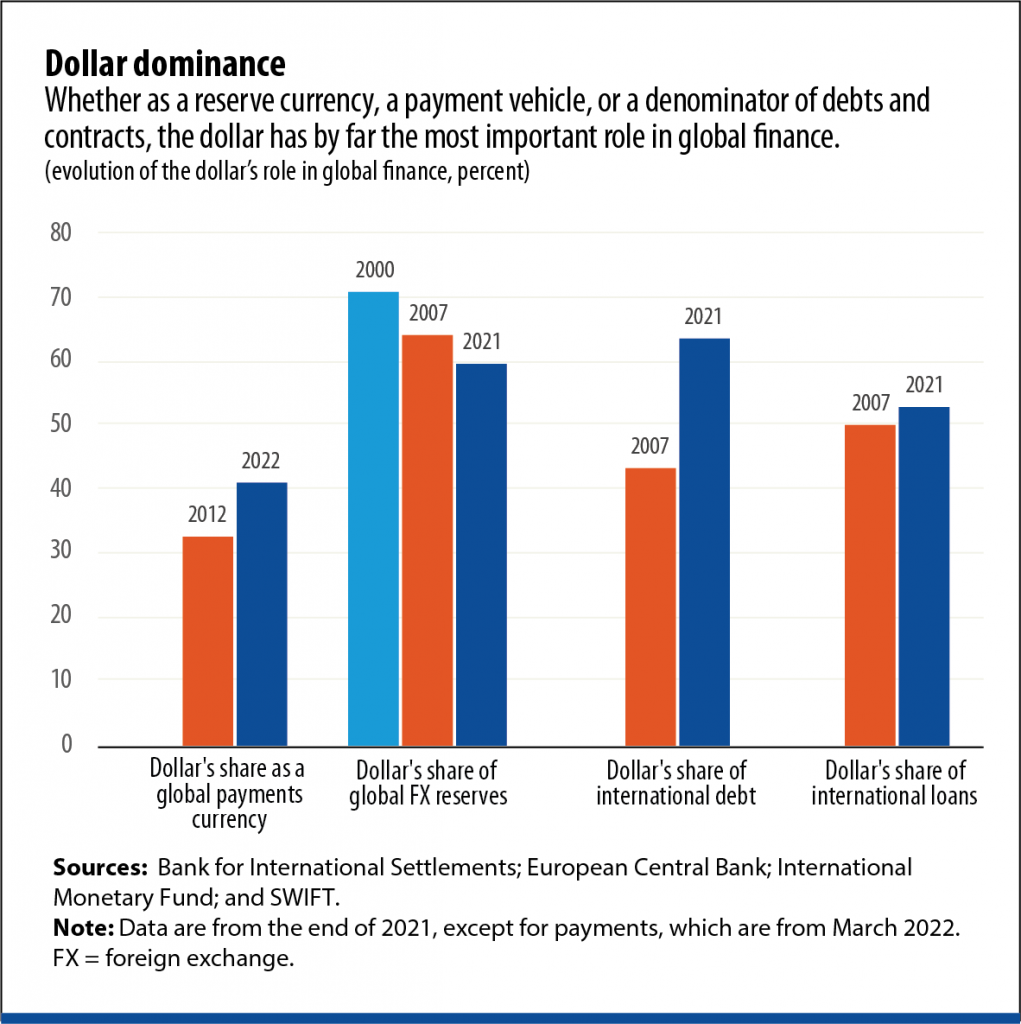Welcome,
Why are global investors so obsessed with the US economy
My dear Friends,
have you ever wondered why so many investors and wealth advisors seem so obsessed with economic data from the US? Be it the rise of interest rates by the FED, Joe Biden´s build-back better program or collapsing American banks. Whatever is decided or happens, investors decipher, predict and act promptly.
It seems if the US economy sneezes, the rest of the world has a cold. Even if investors focus their investments on domestic industries only, they still keep a close watch on what is happening in the US.
Let´s find out why investors around the globe are so obsessed with the US economy!
The world´s biggest economy
The US economy has important effects around the world because of its size and interconnectedness. The fact is, the US is the world’s single largest economy, accounting for almost a quarter of global GDP (at market exchange rates), one-fifth of global FDI( Foreign Direct Investments), and more than a third of stock market capitalisation. It is the most important export destination for one-fifth of countries around the world.
However, the global economy is important for the US as well. Affiliates of US multinationals operating abroad and affiliates of foreign companies located in the US account for a large share of US output, employment, cross-border trade and financial flows, and stock market capitalisation.

Much of the global value chain activity is conducted through US multinational corporations and their affiliates abroad.
As a result, growth setbacks originating in other economies can have detrimental effects on the US. These effects are particularly noticeable in the more globally integrated manufacturing sector.
Synchronised business cycles
Business cycles in the US and other advanced economies have so far been more or less synchronous. This largely also applies to emerging and developing economies.
Around 80% of the time, other economies usually tend to be in the same business cycle phase as the US. The degree of synchronisation with US financial cycles is somewhat lower but still significant. 60% of the time, inflation, interest rates, credit, housing, and equity price cycles are in the same phase.
We currently have a perfect example-inflation went up in the US and across the world almost in lockstep. As a measure, the FED raised interest rates. Soon other countries followed suit to prevent their currencies from taking a major blow.
The recent faster tightening of US monetary policy led to sudden increases in borrowing costs. Thus currency pressures, financial market volatility, and capital outflows for more vulnerable emerging markets and developing economies become dire. With rising interest rates, these countries could default on their debts, with dire consequences for their local economies.
A 2016 research indicates that the US appears to influence the timing and duration of recessions in many major economies.
A global currency
The US dollar is the most widely used currency in global trade and financial transactions. So, any changes in US monetary policy or US investor sentiment play a major role in driving global financing conditions.
Nearly 60 per cent of the world’s central banks’ foreign exchange reserves– their rainy-day funds-are invested in dollar-denominated assets.
The dollar is used to denominate and settle a majority of international financial transactions. The majority of commodity contracts, mainly those for oil, are priced and settled in dollars.

This gives the United States considerable power and influence. Because transactions involving the use of the dollar invariably involve the US banking system. Thus the US government can severely punish countries by imposing sanctions that limit their access to global finance.
It also means that the fiscal and monetary policies of the US government affect the rest of the world. Why? Because this has a strong influence on the value of the dollar. This is why the United States is able to hold so much power over the global economy and why investors are obsessed with the US economy. Something which has long rankled US rivals and allies alike.
Spillover effects
A surge in US economic growth usually provides a significant boost to the global economy. Equally, shocks to the US economy have a ripple effect on the rest of the world.
For example, Joe Biden’s build-back -better program or the inflation reduction act could lift growth in trading partners. The increase in US customer demand could lead to an increase in imports. Thus, indirectly by strengthening productivity spillovers embedded in trade.
The very same program, however, could also do major damage to other economies. A highly subsidised US industrial production will make US goods cheaper and thus more desirable for the global consumer. Importers of goods to the US, like the European Union, could experience an economic slowdown as a consequence.
The US is the world´s largest oil as well as gas consumer and producer. Given its role in global commodity markets, changes in US growth prospects can affect global commodity prices.
The dollar trap
Foreign investors, including central banks, hold nearly $8 trillion in US government debt. Overall, US financial obligations to the rest of the world total $53 trillion. Because these liabilities are denominated in dollars, a plunge in the value of the dollar would make no difference to the amount the United States owes. Yet would reduce the value of those assets in terms of the currencies of the countries that own them. China’s holdings of US government bonds, for instance, would be worth less in renminbi.
The bad news, US investors’ holdings of foreign assets, about $35 trillion, are denominated almost entirely in foreign currencies.
The dollar’s role as the dominant reserve currency will likely persist, even if its status as a payment currency erodes.
eswar Prasad, Professor for trade policy Cornell University
Contagious
Heightened uncertainty driven by financial market volatility discourages investment both in the US and in the rest of the world. The 2022 ambiguity about the direction and scope of US policies turned bullish global stock markets to bear markets.
Trickle-down effects
The US stock market is the biggest stock market in the world, followed by Japan as the second biggest.
News is one of the key elements in the fundamental analysis of stock investments and trading. This news could be of inflation, GDP growth, election results, relief package, debt crisis, fiscal deficit, etc. These events decide the investment by foreign institutional investors (FIIs), foreign portfolio investors (FPIss), etc. This is one of the important factors in understanding why the US market affects the global stock markets. At the end of the day, it is these investments that determine stock markets around the world.
There is a considerable trickle-down effect. A sustained 10% increase in US stock market volatility could reduce investment growth by about 0.6 % in the US. Other developed economies would have a reduction of investment growth of 0.5%. While emerging and developing markets would have a reduction of investments by 0.6%.
So, given the high weighting of U.S. stocks in global sectors and industries, having a U.S. view is important. This refers to investors gaining a clear perspective on the risks and opportunities that exist in the country. Investors can consider the trends influencing American companies in order to help explain stock performance.
Ripples
The recent collapse of some US banks is not only an American problem. It can have serious consequences for the Global economy, as we have seen in 2008.
However, the 2008 financial crisis can not be compared to the current collapse of some regional US banks.
The 2008 crisis, the subprime mortgage -crisis, led to the biggest financial crisis since 1929. It had all started in the US. Two US hedge funds had collapsed. Soon BNP Paribas was warning investors that they might not be able to withdraw money from three of its funds. The British bank Northern Rock was about to seek emergency funding from the Bank of England. What had happened?
Global banks had been heavily invested in mortgage-based hedge funds issued by US-based institutions.
Financial markets around the world had reached the reckoning of a years-long binge on cheap credit facilitated by US policymakers. To encourage economic growth, credit regulation had been loosened. Cheap credits had become widely available and encouraged reckless mortgage lending policies.
When the bubble burst, financial institutions around the globe were left holding trillions of dollars worth of near-worthless investments in subprime mortgages.
The recent collapse of some US banks that had no global connection will not lead to a global financial crisis. Because of contagion fears, however, bank equities around the globe took a severe hit.
The turmoil in the U.S. banking sector isn’t just a problem for the U.S. It also increases the risks of a global recession. Why? The U.S. financial system strains could lead to tighter credit regulations around the globe. The result: an economic slowdown worldwide.
Losing dominance
The international monetary system may be at the threshold of significant change. A combination of economic, geopolitical, and technological forces could throw the dollar off its pedestal. There are changes underway that could undermine the US economy’s supremacy.
US economic dominance is shrinking. The US economy now accounts for about 25 per cent of global GDP, down from 30 per cent in 2000.
The rising power of China is certainly on its way to challenging US economic and dollar dominance. China is today the second-largest economy in the world.
Asian countries, like China and India, would no longer need to exchange their respective currencies for dollars. Rather, exchanging renminbi for rupees directly will become cheaper. Consequently, the reliance on “vehicle currencies,” particularly the dollar, will decline.
It is China’s Cross-Border Interbank System (CIPS), which can communicate directly with other countries’ payment systems, that will enhance the renminbi’s role as an international payment currency.
The emergence of digital currencies is another force. More and more central banks are getting into the game. New technologies increase the efficiency of payment and settlement mechanisms for cross-border transactions.
The central banks of China, Hong Kong SAR, Thailand, and the United Arab Emirates are collaborating on one such effort. Other central bank consortia are engaged in similar exercises.
Speculation has intensified that China’s digital renminbi could gain prominence and perhaps even rival the dollar.
However, the renminbi still lacks some key attributes that reserve currencies typically need. Yet, China has made some progress in this area. They removed restrictions on cross-border capital flows, leaving its currency’s value to market forces. Thus broadening foreign investors’ access to its bond markets.
The fact is new financial technologies will improve access to global financial markets for firms and households, especially in emerging markets and developing economies.
Final conclusion
So, given the high weighting of U.S. stocks in global sectors and industries, having a U.S. view is important. This refers to investors gaining a clear perspective on the risks and opportunities that exist in the country. Investors can consider the trends influencing American companies in order to help explain stock performance.
Short Cuts
If the US economy sneezes, the rest of the world has a cold.
The US is the world’s single largest economy, accounting for almost a quarter of global GDP (at market exchange rates), one-fifth of global FDI, and more than a third of stock market capitalisation.
The global economy is important for the US as well.
Business cycles in the US and other advanced economies have so far been more or less synchronous. This largely also applies to emerging and developing economies.
A surge in US economic growth usually provides a significant boost to the global economy. Equally, shocks to the US economy have a ripple effect on the rest of the world.
Given the high weighting of U.S. stocks in global sectors and industries, having a U.S. view is important. Investors can consider the trends influencing American companies in order to help explain stock performance.
Turmoil in the U.S. banking sector isn’t just a problem for the U.S. it increases the risks of a global financial crisis, similar to 2008.
Speculation has intensified that China’s digital renminbi could gain prominence and perhaps even rival the dollar.






